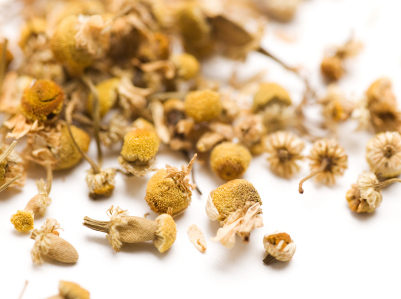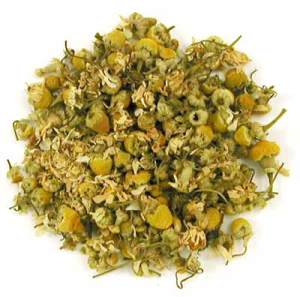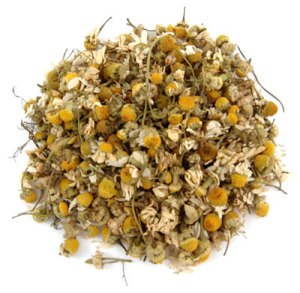Chamomile Basic Information for Tea Drinkers
It’s a hectic world out there — small wonder that chamomile is so popular. After fighting traffic to and from your job, meeting deadlines at work, chasing a child around the house who doesn’t want to take a bath or even wear clothing, or whatever your day is full of, a cup of chamomile is the perfect pre-beddybye-time beverage.

One of the most popular and well-known floral herbals is chamomile (also sometimes spelled “camomile”). Chamomile is a flower that is similar in appearance to the daisy and is in the same botanical family. Snow white wide, flat petals encircle a sunny yellow somewhat spherical center that is much larger than a daisy’s.
This flower has been part of the herbalist’s “toolkit” since ancient Egyptian times, where it was used as a cure for malaria and was dedicated to the sun god, Ra. I’m sure that writer Ellis Peters had crime-solving-soldier-turned-herbalist-monk Cadfael using it to treat the various ills around the monastery in Britain during the 12th century. These days, the two main species of chamomile noted for their medicinal uses are Roman chamomile and German chamomile (don’t let the names fool you, since they are grown elsewhere). However, Egyptian chamomile is widely noted as far more fragrant and flavorful than others.

Chamomile when paired with peppermint has a reputation for aiding digestion and when paired with lemon grass for relaxing nerves. (Caution: Lots of health claims for herbals, including chamomile, are mostly anecdotal and not supported by clinical trials.) One thing I can say from personal experience is that it is relaxing and makes me sleepy. I can’t drink chamomile more than a half hour before bedtime, or I’ll conk out wherever I am sitting, standing, driving, etc. If you have hay fever, be careful about herbals like chamomile, which is part of the ragweed family (a known allergen). They can aggravate your symptoms.
Some health effects chamomile is purported to have:
- Digestive aid (relieves acid indigestion, abdominal pain, and intestinal gas, and helps in cases of diarrhea, constipation, and peptic ulcers).
- Anti-allergenic (unless you are prone to hay fever).
- Relaxing and sedative-like, including calming restless children and hectic-lifestyle-frazzled adults.
- Anti-inflammatory and antibacterial.
- Easing colic and teething pain in babies.
- Relieving headache and reducing fever in colds and flu.
External uses include an eye wash that is reported by some to soothe conjunctivitis, a hot compress to soothe burns and scalds, and a hair rinse to brighten hair. Wow! Quite a reputation to live up to.

Chamomile is a tasty addition to many recipes, from creamy risotto and fried chicken to sweet treats like cream puffs and pancakes. Recipes can call for both steeped chamomile and whole chamomile flowers (as decoration, usually). Try substituting a strongly steeped chamomile in a recipe that calls for tea or things like chicken broth. Here’s a chance to be adventurous in the kitchen, adding a healthy and exotic taste to one of your tried-and-true recipes.
When buying chamomile infusions (often misnamed “teas”), look for Egyptian chamomile. Also, be sure to deal with a reputable vendor to assure you get true chamomile, not pineapple weed, which is sometimes substituted and can cause strong allergic reactions in hay fever sufferers (more so than from true chamomile). Follow package directions to get the proper steep and, thus, the best benefits.
Time for beddy-bye and a cup of chamomile. Cheers!
Before hitting the sack this evening, fix yourself a nice cup of Chamomile and check out A.C.’s blog, Tea Time with A.C. Cargill!



Leave a comment